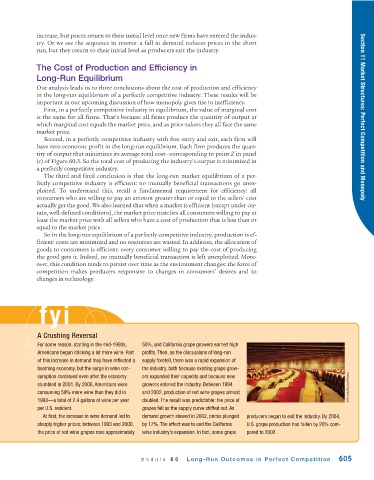Page 647 - Krugmans Economics for AP Text Book_Neat
P. 647
increase, but prices return to their initial level once new firms have entered the indus-
try. Or we see the sequence in reverse: a fall in demand reduces prices in the short
run, but they return to their initial level as producers exit the industry.
The Cost of Production and Efficiency in
Long-Run Equilibrium
Our analysis leads us to three conclusions about the cost of production and efficiency
in the long-run equilibrium of a perfectly competitive industry. These results will be
important in our upcoming discussion of how monopoly gives rise to inefficiency.
First, in a perfectly competitive industry in equilibrium, the value of marginal cost
is the same for all firms. That’s because all firms produce the quantity of output at Section 11 Market Structures: Perfect Competition and Monopoly
which marginal cost equals the market price, and as price-takers they all face the same
market price.
Second, in a perfectly competitive industry with free entry and exit, each firm will
have zero economic profit in the long-run equilibrium. Each firm produces the quan-
tity of output that minimizes its average total cost—corresponding to point Z in panel
(c) of Figure 60.3. So the total cost of producing the industry’s output is minimized in
a perfectly competitive industry.
The third and final conclusion is that the long-run market equilibrium of a per-
fectly competitive industry is efficient: no mutually beneficial transactions go unex-
ploited. To understand this, recall a fundamental requirement for efficiency: all
consumers who are willing to pay an amount greater than or equal to the sellers’ cost
actually get the good. We also learned that when a market is efficient (except under cer-
tain, well-defined conditions), the market price matches all consumers willing to pay at
least the market price with all sellers who have a cost of production that is less than or
equal to the market price.
So in the long-run equilibrium of a perfectly competitive industry, production is ef-
ficient: costs are minimized and no resources are wasted. In addition, the allocation of
goods to consumers is efficient: every consumer willing to pay the cost of producing
the good gets it. Indeed, no mutually beneficial transaction is left unexploited. More-
over, this condition tends to persist over time as the environment changes: the force of
competition makes producers responsive to changes in consumers’ desires and to
changes in technology.
fyi
A Crushing Reversal
For some reason, starting in the mid-1990s, 50%, and California grape growers earned high
Americans began drinking a lot more wine. Part profits. Then, as the discussions of long-run
of this increase in demand may have reflected a supply foretell, there was a rapid expansion of
booming economy, but the surge in wine con- the industry, both because existing grape grow-
sumption continued even after the economy ers expanded their capacity and because new
stumbled in 2001. By 2006, Americans were growers entered the industry. Between 1994 John Lee/Aurora Photos
consuming 59% more wine than they did in and 2002, production of red wine grapes almost
1993—a total of 2.4 gallons of wine per year doubled. The result was predictable: the price of
per U.S. resident. grapes fell as the supply curve shifted out. As
At first, the increase in wine demand led to demand growth slowed in 2002, prices plunged producers began to exit the industry. By 2004,
sharply higher prices; between 1993 and 2000, by 17%. The effect was to end the California U.S. grape production had fallen by 20% com-
the price of red wine grapes rose approximately wine industry’s expansion. In fact, some grape pared to 2002.
module 60 Long-Run Outcomes in Perfect Competition 605

